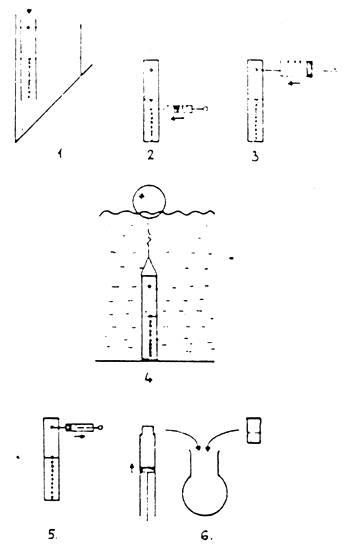From the undisturbed sediment core saturated with acetylene as described for sediment nitrogen fixation, the dinitrogen oxide accumulated during the incubation time is extracted from each layer and measured gas chromatographically.
Hargrave sampler
Sampling and reaction tube (as described for sediment nitrogen fixation)
Rubber stoppers for closing the polyethylene tube
Balloon for gas storing: a football bladder closed with glass stopper.The vacuumed balloon is filled with gas after preliminary rinsing with it. This way the gas can be transported safely for in situ measurement and gas can be withdrawn with needle and syringe
Syringes tuberculin, 1, 20 and 50 cm3 respectively, with well fitting piston and needle of good quality
Perlon string
Lead sinker
Arrangement for gas extraction (cf. Fig. 6)
Gas chromatograph: glass column of 2.1 m length and 4 mm diameter packed with Porapak-N and equipped with electron capture detector.
Acetylene gas (analytical purity)
Dinitrogen oxide standard of chromatographic purity
Saturated HgCl2 solution
The sediment sample is taken with a Hargrave sampler and from here a 20 cm long sediment core such that the upper layer of the core is at the height of the hole in the middle of the tube. The bottom end of the tube is then closed with a stopper. The water above the sediment core is discarded and the tube closed with a rubber stopper. Then 0. 5 cm3 acetylene saturated, ion-free water is injected into the sediment layers through the silicon rubber stopper holes with tuberculin syringe. To obtain a better distribution of the injected solution, this 0.5 cm3 is given in portions at five different angles of the needle. Thus interstitial water of approximately 3–4% acetylene saturation can be obtained. Then 50 cm3 air is with-drawn from the space above the sediment and replaced by the same amount of acetylene gas. The space above the sediment thus contains approximately 15% acetylene. The next step is the incubation in situ for 24 hours by suspending the tube on a Perlon string above the sediment in vertical position (Fig. 7).
Since there is N2O in the reaction flask, both in the sediment and in the gas phase above it, separate measurements are needed.
After incubation 1 cm is withdrawn from the gas phase (Hsample, gas phase) with needle and syringe and directly injected into the gas chromatograph. The column is run at 45°C temperature applying helium as carrier gas.
After analysing the gas phase, the reaction tube is opened at both ends and the sediment core is removed by gentle pushing upward with a piston. Slices of 2 cm thick are cut from the emerging sediment and each put into a flask with round bottom of the gas recovery equipment. Then 5 cm3 ion-free water is added to each flask which is put into the equipment (Fig. 6). Helium gas is applied as carrier at a flow rate of 40 cm3min-1, while the sediment is stirred with a magnetic stirrer for 15 min N2O gas carried by helium is led through the tube containing KOH (10%) so as to eliminate the interfering CO2 and H2O. 3N2O thus purified is then frozen in the spiral (5 cm3 volume) immersed into a thermos containing liquid nitrogen. After 15 min the spiral is transferred into hot water and the N2O released is introduced directly into the gas chromatograph. The chromatographic peak is registered and its height measured (Hsample, sediment).
A control sample is prepared by poisoning the sediment so as to determine the accidental non-biological nitrate reduction during incubation. The control is treated the same way as the sample, with the exception that 1 cm3 saturated HgCl2 solution is injected in each layer. At the end of the process chromatographic peaks corresponding to N2O are registered, their heights (Hcontrol, gas phase, Hcontrol sediment layer) are measured.
The procedure with calibration is the same as described with water. Finally, the chromatographic peak corresponding to N2O is registered, its height measured (Hstandard) and F-calibration factor (nmol N2O. mm-1) is calculated.
The amount of dinitrogen oxide produced from denitrification in the gas phase (ngas phase).
ngas phase (nmol N2O) =

The amount of dinitrogen oxide from denitrification in each sediment layer (ni, sediment) will be:
ni, sediment layer (nmol N2O) =
=(Hsample sediment - Hcontrol sediment)F

Fig. 7 Measuring denitrification in sediment
Sampling with Hargrave sampler
Injecting acetylene saturated water
(0.5 cm3)
Injecting acetylene gas (50 cm3)
Incubation in situ for 24 h
Gas sampling from the space above the sediment
(1 cm3)
Slicing of sediment by 2 cm
The rate of denitrification (v) as related to a unit volume of sediment:

The surface rate characteristic of denitrification as related to a unit region of sediment surface is:
X (nmol N2O cm-2 h-1) = v h
where h = the height of sediment core
Denitrification as related to a longer period of time and extended regions can be obtained by summing the denitrification values (Xik) characteristic of different periods of time and regions.

| where: | tik | = | duration of different periods of time |
| n | = | number of different periods | |
| Fik | = | area of different regions | |
| m | = | number of different regions | |
| K | = | constants depending on the units of measurements chosen. |